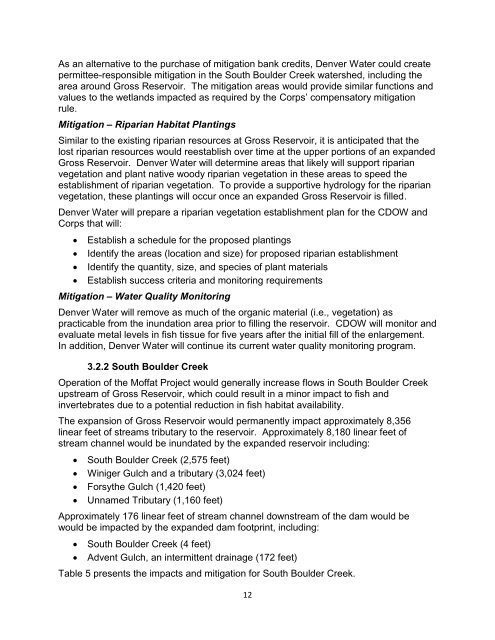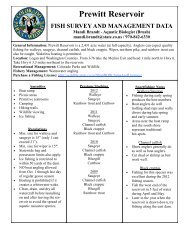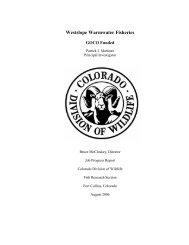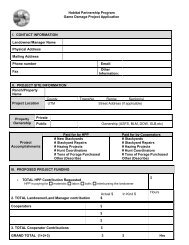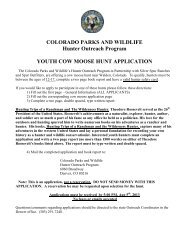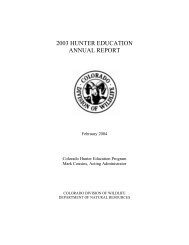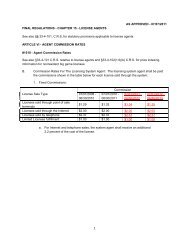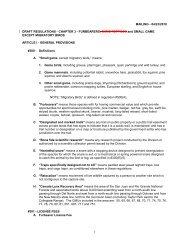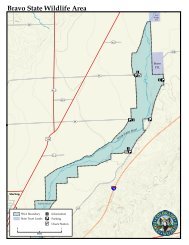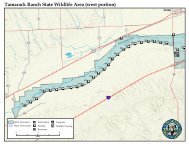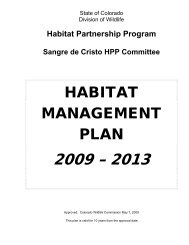Moffat Collection System Project - Mitigation Plan 6-9-11 - Colorado ...
Moffat Collection System Project - Mitigation Plan 6-9-11 - Colorado ...
Moffat Collection System Project - Mitigation Plan 6-9-11 - Colorado ...
Create successful ePaper yourself
Turn your PDF publications into a flip-book with our unique Google optimized e-Paper software.
As an alternative to the purchase of mitigation bank credits, Denver Water could create<br />
permittee-responsible mitigation in the South Boulder Creek watershed, including the<br />
area around Gross Reservoir. The mitigation areas would provide similar functions and<br />
values to the wetlands impacted as required by the Corps’ compensatory mitigation<br />
rule.<br />
<strong>Mitigation</strong> – Riparian Habitat <strong>Plan</strong>tings<br />
Similar to the existing riparian resources at Gross Reservoir, it is anticipated that the<br />
lost riparian resources would reestablish over time at the upper portions of an expanded<br />
Gross Reservoir. Denver Water will determine areas that likely will support riparian<br />
vegetation and plant native woody riparian vegetation in these areas to speed the<br />
establishment of riparian vegetation. To provide a supportive hydrology for the riparian<br />
vegetation, these plantings will occur once an expanded Gross Reservoir is filled.<br />
Denver Water will prepare a riparian vegetation establishment plan for the CDOW and<br />
Corps that will:<br />
Establish a schedule for the proposed plantings<br />
Identify the areas (location and size) for proposed riparian establishment<br />
Identify the quantity, size, and species of plant materials<br />
Establish success criteria and monitoring requirements<br />
<strong>Mitigation</strong> – Water Quality Monitoring<br />
Denver Water will remove as much of the organic material (i.e., vegetation) as<br />
practicable from the inundation area prior to filling the reservoir. CDOW will monitor and<br />
evaluate metal levels in fish tissue for five years after the initial fill of the enlargement.<br />
In addition, Denver Water will continue its current water quality monitoring program.<br />
3.2.2 South Boulder Creek<br />
Operation of the <strong>Moffat</strong> <strong>Project</strong> would generally increase flows in South Boulder Creek<br />
upstream of Gross Reservoir, which could result in a minor impact to fish and<br />
invertebrates due to a potential reduction in fish habitat availability.<br />
The expansion of Gross Reservoir would permanently impact approximately 8,356<br />
linear feet of streams tributary to the reservoir. Approximately 8,180 linear feet of<br />
stream channel would be inundated by the expanded reservoir including:<br />
South Boulder Creek (2,575 feet)<br />
Winiger Gulch and a tributary (3,024 feet)<br />
Forsythe Gulch (1,420 feet)<br />
Unnamed Tributary (1,160 feet)<br />
Approximately 176 linear feet of stream channel downstream of the dam would be<br />
would be impacted by the expanded dam footprint, including:<br />
South Boulder Creek (4 feet)<br />
Advent Gulch, an intermittent drainage (172 feet)<br />
Table 5 presents the impacts and mitigation for South Boulder Creek.<br />
12


